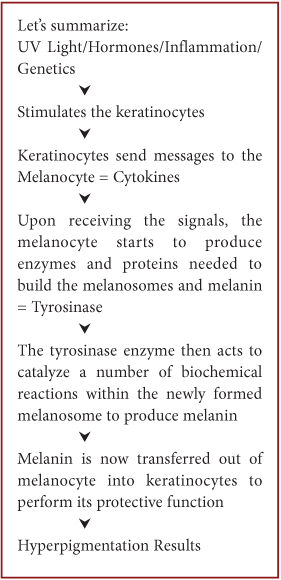The Melanocyte
The melanocyte is a cell located within the basal layer of the epidermis. The primary role of this specialized cell is to produce pigment and provide color to the skin. There are approximately 1500 melanocytes per square millimeter in the skin. They produce two types of pigment melanin; Eumelanin, which is a brown/black melanin; and pheomelanin, which is a red/yellow melanin. Our individual skin color is dependent upon the ratio of eumelanin to pheomelanin, and that ratio is dictated primarily by our genetic makeup.

Similar to the nerve cells in the brain, melanocytes are dendritic in nature, in that they have appendages which reach out to many keratinocytes. Roughly, one melanocyte feeds melanin to about 30 different keratinocytes. The dendrites act as passage ways to transport the melanin to the keratinocytes.
Melanin Production
The production of melanin is referred to as melanogenesis, and is by far, simple process. Melanin is produced within various organelles, or manufacturing sites, within the melanocytes. Once produced, it is molded into spherical bubbles of pigment called melanosomes, and transported along the dendrites of the melanocytes for deposit into the skin cell, the keratinocytes.
The epidermal cells produce signals, called cytokines. These signals are transmitted to the neighboring melanocytes. These signals trigger messengers that tell the melanocyte to begin the melanin production process. One of these messengers is an enzyme called tyrosinase, which when signaled, begins a cascade of biochemical reactions resulting in the synthesis of new melanin. Following synthesis, the melanin is transferred to the epidermal cells producing the visible pigment that we see on the surface of the skin.
The ability to deactivate the tyrosinase enzyme is clearly a key component in controlling pigment production.
It is important to keep in mind that the natural melanin production process is one of the primary protection mechanisms that our skin has against insults from the environment. The primary function of the melanocytes is to produce melanin to protect the skin cells from environmental damage, primarily to protect the nucleus of the cells. The darker the pigmentation produced, the more severe the damage and the more intense the protective efforts… let's take for a quick example, sun exposure: The deeper, darker the tan, the harder the melanocytes are working to protect the epidermal skin cells!
Stimulation of Melanin Production
There are four main factors that stimulate and influence the production of melanin, UV rays from sunlight, our genetic makeup, hormones and hormonal changes, and inflammation. These factors can act independently, or in combination with one another, on the epidermal cells. Understanding these influences is a key in managing pigmentary concerns on the skin, because it is these factors we tend to have the most control over.
Ultraviolet light is our number one offender. Yes, we need sunlight to produce vitamin D, but trust me; we get plenty of it walking back and forth to the car, house, grocery store, and work; we do NOT need to be lying in it! Now, I am absolutely not going to argue the psychological effects of the lack of sunlight. They have long been noted by psychologists across the world, and I live in the Northeast… need I say any more? Ultraviolet rays instantly trigger tyrosinase to activate. Research has actually shown that over 90 percent of aging, not just excess pigment production, but pigment, wrinkles, and age spots, are actually the result of UV exposure. Think about it, 20 years ago we slathered ourselves in baby oil and covered record albums with aluminum foil (boy, did I just date myself)! Now we have sunscreen in our moisturizer, foundation, powders, and body lotions!
I might also add, UV exposure happens to be the one tyrosinase activator that we do have the most control over.
Hormones and hormonal changes throughout life also play a key role in triggering the tyrosinase enzyme, and the series of events that immediately follow producing the pigmentation visible on the skin. A prime example is chloasma, also known as melasma, or the mask of pregnancy. Hormonal influences during pregnancy activate the tyrosinase enzyme, which results in pigmentary changes evident on the face, especially the upper lip, chin, and sometimes the cheeks. These similar reactions result from birth control, changing birth control, and from menopause. There is evidently a hormonal trigger that activates the defense mechanism of the melanocyte in an effort to protect epidermal cells.
Genetic composition of an individual is obviously a force not to be reckoned with, since there really is not too much you can do about it. However, understanding an individual's hereditary background is crucial in understanding their particular melanocytic response to external influences. Proper categorization on the Fitzpatrick Scale will determine the degree of reactivity to UV exposure, the potential for post-inflammatory hyperpigmentation, as well as the possible ration of eumelanin to pheomelanin in the skin. For example, the ration of eumelanin to pheomelanin in Asian skin is actually 16:1, making perfect sense as to why Asian skin is so acutely prone to hyperpigmentation.
Inflammation, resulting in post inflammatory hyperpigmentation (PIH), is a common tyrosinase activator. Inflammatory responses within the body and the skin trigger a host of protective physiological responses. From immunological activation of langerhan cells and histamines to the production of melanin, the skin's ability to protect the health of its epidermal cells is innate.
The important thing to consider is the types of things that cause inflammatory responses. This is where your role, as an aesthetician and educating your clients is imperative to healthy, beautiful, non-pigmented skin. Many of the skin care treatments designed to promote cell turnover and healthy skin inflict damage on the surface in an effort to promote the cell renewing process. When damage is inflicted and the repair mechanisms are stimulated, inflammatory responses are also triggered. It's a natural defense and repair mechanism. Inflammatory responses naturally trigger tyrosinase… ending in PIH.
Now that you have an understanding of how pigmentation is produced and what factors stimulate that production, you can now begin the process of determining how best to help your clients combat hyperpigmentary issues and concerns.
Skin Lightening Ingredients
There are a host of ingredients that are used to treat excess pigmentation. Very few of them are actually "bleaching" agents; the majority of ingredients are tyrosinase inhibitors. This simply makes the most sense, since you now know that the tyrosinase enzyme is the primary trigger of melanogenesis. Other ingredients act by blocking the messages being sent from the keratinocytes to the melanocyte, and by inhibiting the transfer of the melanin from the melanocyte into the keratinocytes. Hydroquinone – over the counter at two percent and less.

- Black Cohosh
- Asparagus
- Magnesium Ascorbyl Phosphate – Vitamin C
- Lotus Root Extract
- Glabridin – Licorice root
- Arbutin
- Azaleic Acid
- Wheat
- Plum
- Kojic Acid
Proper use, and recommendation for use, of skin lightening ingredients falls within the realm of professional responsibility of the aesthetician. The role of all of these ingredients is to – in some way, shape, and form – turn off the body's natural protective mechanism of melanin production. Remember, melanin production is stimulated in an effort to protect epidermal cells from damage. Therefore if we are turning off these protective mechanisms, we better have a plan in place to protect the epidermal cells… sun screen. Skin lightening ingredients should not even be a consideration without the accompaniment of an SPF 30.
Additionally, in an effort to promote cell turnover and a more youthful surface appearance, a multitude of peeling agents and exfoliants can be used. From alpha hydroxy acids to Jessners' Solution, Trichloracetic Acid, microdermabrasion, and laser… what one commonality exists with each form of exfoliation? Inflammation. This means that prior to performing any of these treatments, a pre-treatment protocol of a tyrosinase inhibitor is crucial if you want to avoid post-inflammatory hyperpigmentation.
It is easy to see how it all falls together. Simply understanding what hyperpigmentation is, is not enough. Once you understand what it is, how it develops, and what triggers it, you can prevent and improve it. You are a skin care professional for a reason. Your knowledge and skills have made you who you are, and your ethics and practice have created a profession. What we see on the outside comes only from within. We cannot help our clients to improve it if we don't understand how it works! …and now you know!

Michelle D'Allaird is a New York State licensed aesthetician and International CIDESCO Diplomat. She is the owner of the Aesthetic Science Institute aesthetic schools in Syracuse and Latham, N.Y. She is a consultant and educator for international cosmetic companies around the world. D'Allaird is a contributing author to major industry trade magazines, as well as a host and speaker for International Congress of Esthetics & Spa conferences in Miami, Philadelphia, Dallas, and Long Beach. She is also a co-author of Salon Fundamentals aesthetic textbook. Her expertise lies in education and curriculum development for aesthetic, medical, and laser courses.
Want to read more?
Subscribe to one of our monthly plans to continue reading this article.